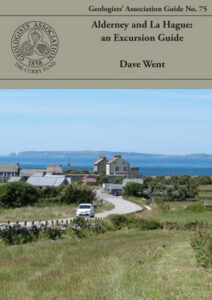By Dave Went

Recently, the Geologists’ Association kindly sent me three of their new guides to review, and I chose to review Alderney and La Hague: an Excursion Guide first, for some very personal reasons. I remember fondly my visits as a child to Alderney, and my extensive civil engineering works on Corblets beach, building dams of sand to capture the water flowing across the sand into the Race of Alderney.
I also remember taking my youngest son on his first beach holiday there. So, imagine my surprise and delight to see an itinerary to that very beach, set out in the guide, as part of Excursion 2. And, that the sandstone I build said dams next to, consists of beds of pinkish-red, very course grained sandstone of Cambrian age, from the Alderney Sandstone Formation (Corblets Sandstone Member).
In fact, I never realised just how diverse the rocks of this – the smallest of the Channel Islands – is. They are clearly well exposed and easily seen along the coast (and the cliffs are wonderful to look at). The guide also points out that the island’s rocks provide the best opportunity to see intrusive, igneous suites of the Cadomian orogeny (a tectonic event or series of events in the late Neoproterozoic, about 650 to 550 million years ago), and the lower Cambrian fluvial strata associated with post-Cadomian sedimentation. And I know from personal experience that each of the walks will be a delight, as the island is phenomenally beautiful.
Unfortunately, I do not know the area around La Hague in France. However, the itineraries selected in the Cotentin Peninsula provide the opportunity to see the more basinal, deltaic and marine components of lower Cambrian, post-orogenic deposits,in addition to younger Ordovician strata formed during the rift-drift phase of the opening of the Rheic ocean, in the Early Ordovician. The Quaternary rocks of the region are also different from those that tend to be found in mainland Britain. In addition, the area was south of the maximum extent of the ice during the Pleistocene, and therefore preserve good examples of periglacial deposits and landforms. And, like the itineraries on Alderney, the scenery clearly looks great.
There are also many other, non-geological things to see in both Alderney and La Hague, These include the spectacular coastal geomorphology referred to above, and wildlife, notably the seabird colonies of gannets and puffins around Alderney. (The gannet colony, on the tiny, rocky island/stack of Les Etacs, situated 100m from the cliffs, is a must-see, but smells dreadfully.)
There are also archaeological sites featuring Neolithic remains at Cap Rozel, and numerous historic structures on Alderney from Roman, Napoleonic and WW2 times. (For example, from WW2, you can see the memorial to the Lager Sylt concentration camp on Alderney, and there are imposing gun emplacements built by the occupying Germans.) And a great thing about the guide is that these historical sites are incorporated into the itineraries.
I thoroughly enjoyed reading this guide, and it may well inspire me to return.
Alderney and La Hague: an Excursion Guide, by Dave Went, The Geologists Association, London (2022), 100 pages (paperback), ISBN: 978-1-9996757-2-1.


